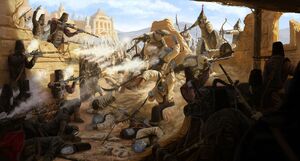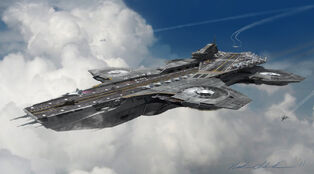The Great War of the Martians (or also The Great Martian War or even The Long Martian War) was a global war that lasted from 1528 to 1642 of the human calendar. It involved the total of the martian states and/or organizations, all of the great powers—eventually forming two opposing military alliances: the Pure Alliance and the Supremes. It was the most widespread war in history, and at the end it directly involved the whole population of the martians. At the end, in a state of "total war", the major participants threw their entire economic, industrial, and scientific capabilities behind the war effort, erasing the distinction between civilian and military resources. Marked by mass deaths of civilians, and the use of nuclear weapons, it resulted in an estimated 1 to 1.5 billion casualties. These made The Long War of the Martians the deadliest conflict in the history of known space.

The War started to be fought with low tech weapons
Human and Martian historians tend to divide the 114 years conflict into 4 main periods: The First Division, Sketch/Incomplete Peace, Total War, & Nuclear War.
By the XVI century from the human calendar, Mars had developed three zones with similar development, rather than just one as in Earth (Europe); all of them sharing a similar level of technology (Napoleonic era technology) [see Martian History].

Trenches were widespread during the first 10 years of the Total War period
The war is usually accepted to have started on 1528 HC (Human Calendar), though many of the records have been lost to be 100% accurate. The Kuta Kingdom aimed to dominate the resource rich island of SSefdo and the archipelagos between its mainland and the island continent and thus declared war to the Empire of Keehss, that controlled the archipelago. From the late 1520s to early 1560s, in a series of campaigns and treaties, Kuta formed an alliance and conquered or controlled much of the lesser continental mass (Buno), and formed the Supreme alliance with 33 other countries, under the banner that their ideologies were to prevail on Mars.
Following The Pact in 1577 HC (records on whom signed it or where, are lost), the Supreme alliance and the Pure alliance (lead by the Twasso Empire) partitioned and annexed territories of their neighbours, virtually dividing the world in two. The Empire of Keehss was the only great power that didn't signed The Pact and thus continued a war against Kuta. By this time the Martians developed technology similar to that of the humans at the beginning of the XX century.

Massive land campaigns were ubiquitous during the war.
In 1586 HC, the Pure powers launched an invasion of the Great Gap, the central archipelago separating the two main continental masses, controlled by a confederation of states aligned with the Supreme alliance, which started the Total War period.

At the end of the war, speed of the campaigns was so fast that the building of land based air bases became impractical and thus the martians armies designed and build airborne aircraft carriers similar in design to those at sea but build for land operations. Low gravity made this posible.
As the conflict evolved to be the first industrial war in martian history, new devastating weapons and methods were employed, such as trench warfare, poison gas, aerial bombing, and finally nuclear weapons.
Massive land campaigns involving millions of units and strategic bombings with thousands of aircraft, extensive naval battles –one involving more than 200 ships and more than 2,000 aircraft, and 50 massive amphibious invasions (all of them the size of our-timeline D-Day), all of them promising to break the front or even to bring an end to war. Millions of deaths make that most societies evolved into militaristic regimes, where military service was obligatory in most parts of Mars, and it involved fighting directly on the front or servicing directly on the armed branches of the state (like in our-timline Israel).
After more than 54 years of continuous confrontations between the world powers, technological development led to the creation of nuclear weapons on Mars. Development and production of this weapons was very slow, due to the strain of resources.
It is estimated that between 750 and 900 nuclear warheads were detonated. After the first bomb was dropped, war only lasted a little bit more than 1 year.
The First Division[]
These minor wars dragged on for decades causing major changes in the societies involved, with rapid industrialization and technological advance.
Sketch Peace[]
Also known as the Incomplete Peace, is a short period comprising from 1577 to 1586 HC where small factions lead or financed by either the Pure or Supreme alliances clashed; a mini Cold War.
Total War[]

Alliances system at the beginning of the Total War Period
This period is defined by mass industrialization, mass conscription, and mass casualties.
Nuclear War[]
[See Long Winter]
Around 800 nuclear warheads were detonated.

Red dots represent targets that were hit by at least one nuke.
Great cities of the martian civilization went up in smoke and nuclear fire, Ssiud, Xhosu, Ossii, and Waa, all of them are nothing more than a name on history. According to the martian historian, Lenss Waku, it is like "(...) if humanity would have lost Rome, Paris, Moscow, Tokyo and the like in just one blink".
The downfall to nuclear fire of the Martians wasn't in just one blow as in the MAD scenario, but a slow descent into the vortex of oblivion. This was due to the nonexistent stockpile of nuclear weapons and its extremely slow production when the first one exploded.
Instead of hundreds of missiles flying at once in the sky and blowing up billions of lifes in just one day, bombs were used as they were finished, destroying one military objective at a time. It wasn't until after several dozen detonations that cities started to become targets for nuclear weapons. At its most critical time, four nuclear bombs were detonated per week.
The remaining military units were called home to help reestablish order, other were left stranded in foreign countries with no means of getting them out, but most of them were MIA.
There is no register of a peace treaty nor an armistice, and there is no formal date of the finishing of the hostilities. The last offensive by conventional warfare was an attempt to conquer the island-fortress of Nwaaw by the dictatorship of Schwa by a meaningly force of less than 1000 martians. The last registered detonation of a nuclear bomb was in the Nwaaw Fortress on 5 July 1642.
Aftermath[]
Nuclear exchange made the environment to slowly collapse, with a long nuclear winter looming in the horizon. As the weeks started to become colder, harvests started to fail and martians started to starve and riot. The cities that were left started to get empty; the martians that didn't died in the rioting or by radiation poisoning, went to the country looking for food. Production of almost everything slowly stopped. Governments collapsed all around Mars; just a few too isolated from the rest of the world or too strong or relatively unscathed by the nuclear storm remained and tried to reestablish order.
Most of Mars was left in anarchy and the survivors left to fend for themselves.